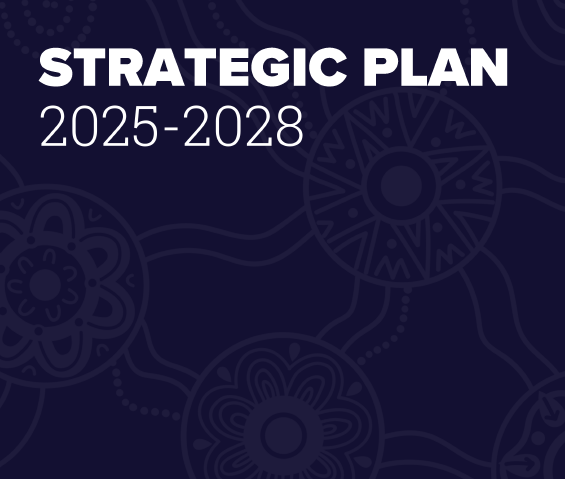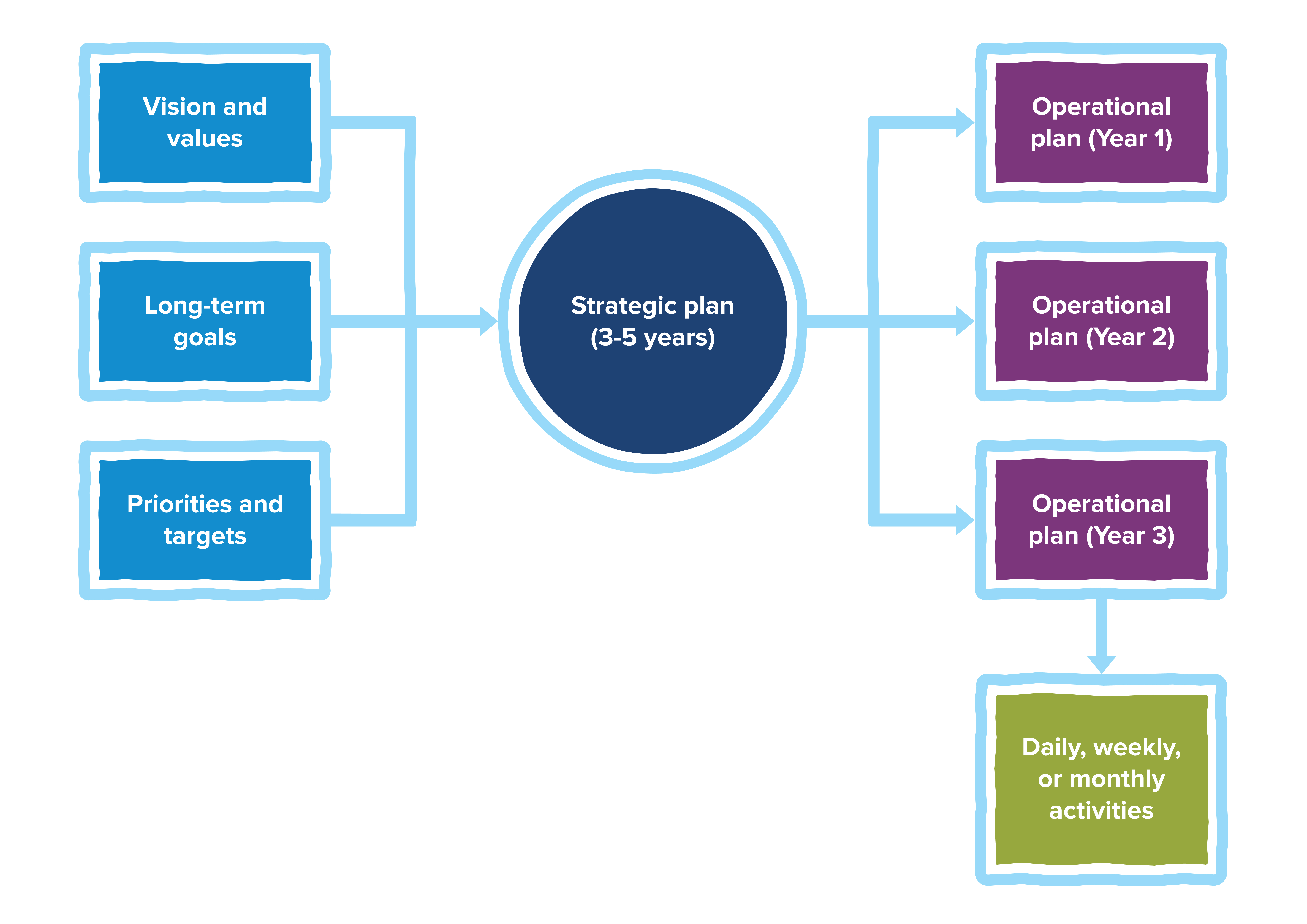Celebrating a Trans-Tasman Partnership: Māori and Australian First Nations Governance Leaders Unite...
Strategic planning

In this topic, we introduce you to strategic planning. We show you how to create an effective strategic plan for your group. We also look at steps you can take to monitor and evaluate your plan.
While reading this topic, think about the following questions and how they relate to your organisation, community or nation:
- Why is planning important for governance?
- What is a strategic plan? What might be included in your strategic plan?
Importance of strategic planning
Strategic planning is an important element of effective two-way governance. It’s about the big things you want to achieve for your members.
Strategic planning gives your governance a better chance of staying on track. It’s also a way of being ready to make your own decisions about your future, rather than having them imposed on you from the outside.
You may know the saying ‘If you fail to plan, you plan to fail.’ This is a good reminder of the importance of planning.
Creating a strategic plan involves choosing a specific objective, allocating resources and monitoring your success.
A strategic plan generally sets out your:
- vision and values
- long-term goals
- priorities and targets
- specific solutions, strategies and timeframes for achieving each of those.
What you set out in your strategic plan informs the development of your operational plan.
Operational planning is different to strategic planning. Strategic planning is about your long-term goals and working out how you can achieve them. Operational planning is about the short-term goals, actions and tasks you need to complete to achieve these goals.
A group uses their operational plan to help them implement their strategic plan.
An operational plan is a written document that sets out your group’s daily, weekly or monthly actions and tasks for the next twelve months (or less). It identifies important short-term goals and the steps you can take to achieve them. In this way, an operational plan is part of your strategic plan.
Organisations, communities, and nations can use an operational plan to:
- effectively allocate resources
- define members’ roles and responsibilities
- determine timelines to complete tasks.
An operational plan provides members with a clear picture of what they should be doing to achieve the strategic plan, when they should be doing it, and how.
The board officially adopts the strategic plan at a directors’ meeting. The managers and staff can implement the strategic plan using the operational plan and report on progress to the board.
To achieve your strategic plan, you must have the support of your group members, leaders, and Elders – including those in your wider networks.
When you plan effectively, it can help you:
- communicate better with your members
- provide members with a sense of belonging and understanding of your group’s goals
- make sure everyone is aligned with your goals
- draw on the strengths, experience and expertise of all your members and staff
- look at the big picture of where you’re heading
- measure how well you’re doing
- prepare for events that may happen in the future.
Your organisation, community and nation can use plans to:
- define short-term and long-term objectives, and prioritise how they’ll be achieved
- assign roles and responsibilities so the board and staff have a shared understanding
- track progress and outcomes, creating a basis for future evaluations
- ensure accountability by helping the community understand your work and commitments
- make sure your services meet the changing needs of your members
- set up a reliable process for routine operations and projects
- set up strong relationships with government and other agencies to be ready for any external financial, policy and funding changes.
Develop your strategic plan
Strategic planning is the responsibility of your board. Your strategic plan should:
- be short and easy to understand
- be consistent with your values and vision
- include your operational plan
- give staff challenging, responsible assignments and realistic timeframes
- list actions and tasks
- be regularly assessed.
A strategic plan can cover up to five years, but you should review it annually.
For your strategic planning to be effective and culturally legitimate, it should involve:
- the members of your organisation, community, or nation – to help identify future goals and priorities
- your leadership network – including the board, CEOs and Elders
- your staff – to provide information, advice and analysis
- an enthusiastic coordinator – to pull it all together
- external stakeholders, such as government or other organisations – to make make valuable contributions to planning.
“Leaders may have developed the most ingenious strategy ever, but it means nothing if it doesn’t get done. The better conceived your organisation’s strategy and the more competently it is executed with accountability and measurement, the more likely it will get done and please the community … First Nations usually have limited … resources and selecting the best possible strategies also requires an answer to the questions, ‘What could we do and what are we able to do?’”
– Jim Pealow, Strategic Management and Accountability for First Nations: Best Practices to Consider.1Jim Pealow, Strategic Management and Accountability for First Nations: Best Practices to Consider, (Canada: Institute of Governance, 2020), [link].
There are different approaches to developing your strategic plan, but most follow these key steps:
1. Prepare to plan
Assess if your group is ready for the planning process.
- Decide who’s involved at each stage.
- Decide what resources and information you need at each stage.
- Identify the points decision-making is needed.
2. Understand your wider environment
- Analyse the different people around you that affect your organisation.
- Consider factors that may be important to your future.
- Evaluate how well your group is currently working.
- Consider views and feedback from your members, leaders, and external stakeholders about developing your strategic plan.
3. Define your vision and purpose
Defining your vision and purpose is a fundamental role of your governing body. You should develop it with your management and staff.
Your vision statement should reflect the values of your group. Focus on what your governing body and members would like to do in the future – including your impact on the community.
Your purpose statement to describe your purpose – your reason for being. It should explain what your organisation, community or nation does, and for whom (in one or two sentences).
4. Define your strategic goals
Your goals are the specific priorities your group will focus on. They define what you want to achieve during this time period.
- Make your goals consistent with your vision and purpose.
- Describe the desired directions or outcomes for each goal.
- Define how success will be evaluated for each goal.
5. Define your operational objectives
Your operational objectives describe how you will implement each strategic goal. These are usually developed annually.
- Make your objectives short-term and measurable.
- Describe how you will meet each strategic goal – be specific.
6. Allocate resources
Your strategic plan must include the actions required to implement each strategic goal – this is your action plan.
- Include a timeline for all actions.
- Detail who is responsible for each action and who supports these people.
- Provide details on the resources required – including materials, money and information.
- Identify the decision points in the process.
- Monitor and evaluate the achievement of each strategic goal.
7. Monitor, evaluate and assess
Your board is responsible for monitoring, evaluating and assessing the implementation of your strategic plan.
Evaluation should include how your activities impact your community members and stakeholders.
For more details about this step, see Monitor and evaluate your strategic plan below.
Aboriginal and Torres Strait Islander viewers should be aware that this video may contain images and voices of persons who have passed.
Marlene Spencer and Sarah Brown explain how the board of the Purple House (formerly Western Desert Dialysis / WDNWPT) prioritised and developed a five-year strategic plan for their organisation.
Monitor and evaluate your strategic plan
Successful organisations, communities and nations regularly monitor and evaluate their strategic plan. This gives them the opportunity to make decisions to change what’s not working and craft solutions. Leaders cannot just ‘set and forget’ strategies.
By regularly evaluating your strategic plan, you can:
- understand if you have achieved your goals
- reinvigorate your group’s momentum to reach your objectives
- identify any elements of your plan that need to be revised to reflect new opportunities or risks
- re-engage your members with your strategy and remind them how they contribute to your future vision.
How often you should review your plan depends on your organisation. Regular reviews help to keep your strategy on track.
Your strategy does not have to be redone after every review. Although changes may have to be made, it is important that your overall direction remains consistent.
There are different ways to evaluate your strategic plan. Most follow these 3 stages. Repeat these stages each time you review your plan:
1. Review
Look at your plan as a whole – the ‘bigger picture’.
Examine each element of your plan in more detail by evaluating your objectives, goals and focus areas.2“Strategic plan review,” Conscious Governance, accessed 2023, [link]
- Is your overall strategy still valid? Does it still reflect your values, vision and mission?
- Do any objectives need to be reworked? Are they all still relevant?
- Have there been any changes within your group or the wider environment that influence your strategy? For example, changes to funding or resources.
2. Evaluate
Evaluate your success in reaching your goals or objectives. Think about whether you have made progress towards your vision. One way to do this is to evaluate your performance measures and targets.3Tom Wright, “Strategy Evaluation Process: Comprehensive Guide + Examples,” Cascade, March 2022, [link]
Think about what you use to measure progress against your objectives – for example, do you measure:
- health outcomes
- how many community members access your services
- how many successful native title determinations per year?
Each performance measure needs to have a realistic target.
Once you’ve decided on your performance measures and targets, ask yourself if you’ve been successful in achieving them. Make sure you discuss with your members to get their input.
If your performance measures are not being met, think about the reasons why. You may need to review your targets to make sure they’re realistic and achievable.
This is also a chance to reflect on what you did well, and what you can do to improve on this success. If you have completed a strategy review in the past, think about the progress you have made since then.
3. Communicate
If you make changes to your plan, it’s important to record and communicate these with your members. Sharing updates to your plan helps everyone understand what needs to be done and what their responsibilities are.
We’ve translated our extensive research on Indigenous governance into helpful resources and tools to help you strengthen your governance practices.
Stay connected
Subscribe to AIGI news and updates.









.png)



